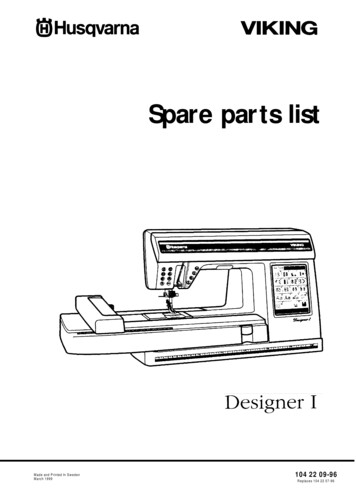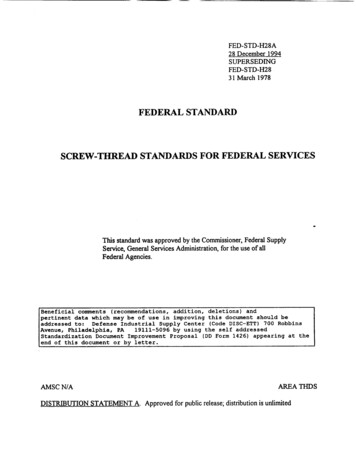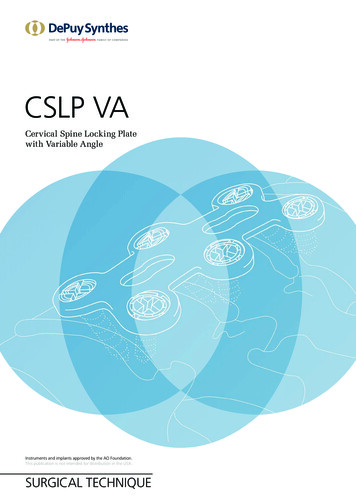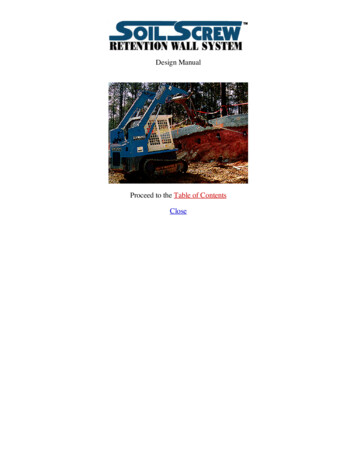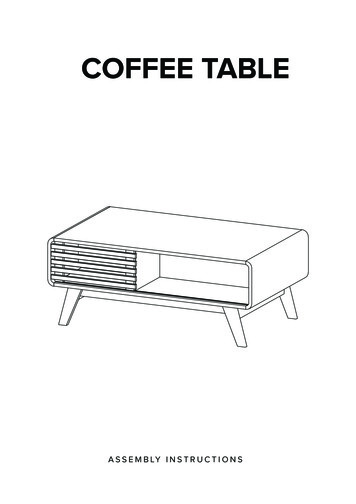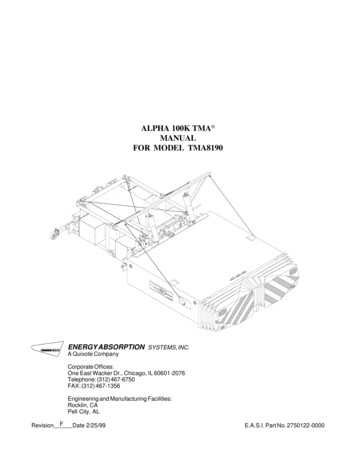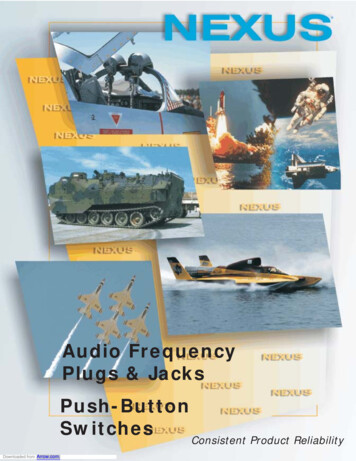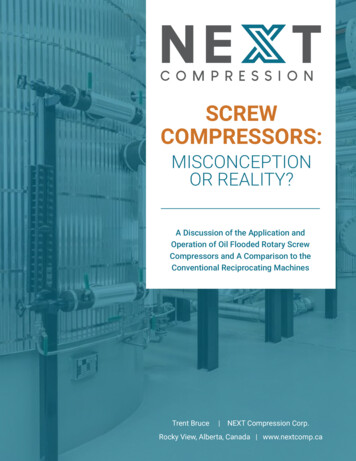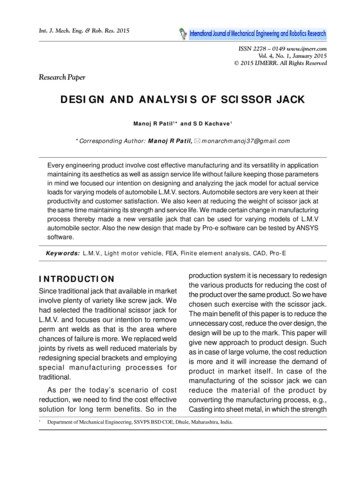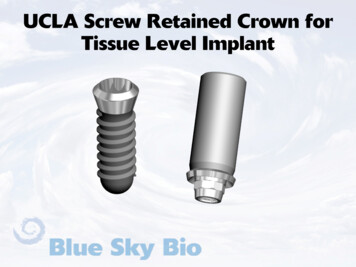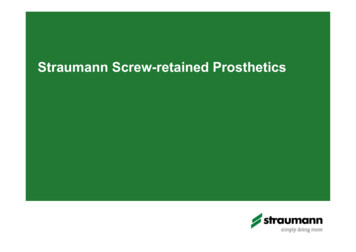
Transcription
Section 1.1. Screw Jack Idea and Application GuideScrew Jack (Mechanical Actuator) Product SummaryTypical Applications and AccessoriesSelecting an actuatorProduct CodesSym-metric (CUBIC) Actuators25kN to 200kN capacities with Machine ScrewTranslating and Rotating screw3 gear ratios and 2 screw leads as standardAnti-backlash & Anti-rotation (keyed) optionsSection 1.2.1Sym-metric (Cubic) ActuatorsS-SeriesMetric Single Face Screw Jacks (mechanical actuators)5kN to 1000kN capacities with Machine Screw or Ball ScrewTranslating and Rotating Screw in Upright and Inverted types2 gear ratios and 1 screw lead as standardBall screw units have 2 screw lead optionsAnti-backlash and Anti-rotation (keyed) options6 mounting options including trunnion and double clevisSection 1.2.2. and 1.3.1.Metric Single Face ScrewJacks (Mechanical Actuators)E-SeriesSection 1.2.3. and 1.3.2Imperial Single Face Screw Jacks (mechanical actuators)1/2 Ton to100 Ton capacities with Machine Screw or Ball ScrewTranslating and Rotating Screw in Upright and Inverted types2 gear ratios and 1 screw lead as standardBall screw units have 2 screw lead optionsAnti-backlash and Anti-rotation (keyed) options5 mounting options including double clevisImperial Single Face ScrewJacks (Mechanical Actuators)M-Series1. screw jacks (mechanical actuators)Section 1.2.4. & 1.2.5.Metric 10kN to 1000kN capacities with Machine ScrewImperial 2 Ton to 100 Ton capacities with Machine ScrewTranslating and Rotating Screw in Upright and Inverted types2 gear ratios and 1 screw lead as standardAnti-backlash and Anti-rotation (keyed) options5 mounting options including double clevisStainless Steel (E) Metric and(M) Imperial (Single Face)ActuatorsSection 1.2.6.Metric or ImperialUp to 450kg capacities with Machine ScrewBalanced or continuous dial typesMicro-Miniature ActuatorsSection 1.4.Roller Screw & Special ActuatorsRoller Screw Jacks for high duty applicationsModified screw jacks e.g. material, paint, screw lead, etc.Special additional features e.g. wear indicator, safety nuts, etc.New design tailored to exact customer requirementsHigh Duty andSpecial Screw JacksSection 1.5.Screw Jack (Mechanical Actuator) Engineering GuideActuator performance chartsActuator product operation featuresInstallation and maintenance tipsEngineering GuidePower Jacks GroupSouth Harbour Road, Fraserburgh, Aberdeenshire, AB43 9BZ, Scotland, UKtel: 44 (0) 1346 513131fax: 44 (0) 1346 516827email: sales@powerjacks.com web: www.powerjacks.com
section indexSection Index1. Screw Jacks (Mechanical Actuators)Cubic Metric Machine Screw ActuatorsMetric and Imperial Machine Screw ActuatorsStainless Steel Actuators - Metric and ImperialMicro-Miniature ActuatorsBall Screw Actuators - Metric and ImperialRoller Screw and Special Actuators2. Linear ActuatorsEMA - Actuator SeriesRolaram Actuator Series3. Screw DrivesSpiracon Roller Screw4. Bevel Gearboxes - Neeter DriveP-Range Series 2000 and 4000N-Range Series 35, 37, 38, 39 and 40BA-Range Series L, H, and K5. Reduction GearboxesHelical Worm GearboxesIn-Line Helical Gearboxes6. Couplings and Drive ShaftsJaw and Gear Flexible CouplingsDrive ShaftsPlummer BlocksHand Wheels7. Electric MotorsStandard 3-Phase MotorsBrake MotorsMotors with Encoders and Forced Ventilation8. Motion ControlRotary Limit SwitchesProximity and Electro-mechanical Limit SwitchesEncoders - Incremental and AbsolutePosition IndicatorsControl Panels9. Engineers ReferenceFormulae and FactorsStandard Metric Component DataPropertiesWarrantysectionindex1
picture indexPicture IndexCubic ActuatorsMetric ActuatorsMetric Ball Screw ActuatorsStainless Steel ActuatorsBall Screw Rolaram ActuatorEMA ActuatorsImperial Actuators2pictureindexRoller Screw Rolaram ActuatorImperial Ball Screw ActuatorsRoller Screw and SpecialActuatorsSpecial ActuatorsSpiracon Roller Screw
picture indexP-Range Bevel GearboxesN-Range Bevel GearboxesBA-Range Bevel GearboxesElectric MotorsHelical Worm GearboxesIn-Line Helical GearboxesCouplings andDrive ShaftsRotary Limit SwitchesEncodersPosition IndicatorsProximity and Contact LimitSwitchesEngineers Referencepictureindex3
company profileCompany ProfilePower Jacks is the largest and most experiencedmanufacturer of actuators and mechanical jacks in the UK.With our range of Power Jacks and Duff-Norton actuatorsyou don’t just get the product, you also get the knowledgeand experience from a company that has, since 1883,manufactured quality industrial lifting, positioning andmaterials handling equipment.On our extensive site in Fraserburgh, Aberdeenshire, we havea wide range of engineering facilities including CAD/CAM/CAE technology to aid engineering design and manufacture,an advanced production control system ensuring theoptimum product flow through our comprehensive range ofconventional and CNC machining facilities, which maximisesefficiency and reduces delivery times. This is achieved withour 100 highly trained employees, giving Power Jacks thecapability to produce mechanical engineering of the higheststandards.Quality is a key part of Power Jacks working philosophy andbuilt into the product from initial design conception, throughproduction, to installation and after sales service.There are over two million of our actuators successfully inoperation world-wide. The Power Jacks Group are a globalmarket leader in Linear Actuation Systems.Power Jacks Ltd Extensive Site in Fraserburgh, AberdeenshireBy specifying a Power Jacks product you are assured of quality,reliability, performance and value. In the United Kingdom thereare a team of highly experienced sales engineers to assistcustomers with their actuation applications whether on site orby direct communications with the Fraserburgh factory. Foroverseas customers there is an extensive distributor networkworld-wide.4company profile
company profilePower Jacks Standard Product Range Covers:Machine Screw Worm Gear Actuators (Screw Jacks)Ball Screw Actuators (Screw Jacks)Stainless Steel Actuators (Screw Jacks)Micro-Miniature ActuatorsTracMaster Electro-Mechanical Linear ActuatorsEMA Electro-Mechanical Linear ActuatorsRolaram Electro-Mechanical Linear ActuatorsMechanical JacksNeeter Drive Bevel Gear BoxesReduction Gear BoxesPower TransmissionsAccessories for Complete Actuator SystemsActuator Motion Control SystemsTrack (Rail) JacksHydraulic JacksHydraulic CylindersHydraulic Pumps and ToolsBoth Metric and Imperial Products are available.For more information contact:As well as these standard products Power Jacks has adedicated engineering team for the design of “Special”products to suit all customer requirements.Power Jacks LtdSouth Harbour Road Fraserburgh AB43 9BZTel: 44 (0) 1346 513131Fax: 44 (0) 1346 516827email:sales@powerjacks.comInternet: http://www.powerjacks.comThese products can be provided as individual partsor single or multiple systems with full engineeringconsultancy available as par t of the service.companyprofile5
company profileCompany ProfileThe Power Jacks Group is an engineering group focused on providing customers with the best solution for precision linear actuation,power transmission, mechanical jacking, hydraulic jacking and engineering service. The engineering history of the group dates from1883 and the products and service are supplied to customers world-wide.The Power Jacks Group Brings TogetherNEETER DRIVEPOWER JACKSS P I R A LB E V E LPOWER JACKSpG E A R B O X E SYoungs LiftinguGroFORTUNEE N G I N E E R I N GRepresentation6companyprofile L T DPRECISIONA C T U AT I O NS Y S T E M S
screw jacksContents1.1.1.1.2.1.3.1.4.1.5.Screw Jacks (Mechanical Actuators)Idea and Application Guide21.1.1.Screw Jacks (Mechanical Actuator) Product Summary21.1.2.Typical Applications31.1.3.Selecting an Actuator71.1.4.Preview of Actuator Accessories141.1.5.Actuator System Selection Guide161.1.6.Worksheet/Application Analysis Form181.1.7.Actuator Product Codes for Ordering19Machine Screw Actuators231.2.1.S-Series (Sym-metric) Actuator Models231.2.2.E-Series Metric Machine Screw Actuator Models351.2.3.M-Series Imperial Machine Screw Actuators Models531.2.4.E-Series Metric Stainless Steel Machine Screw Actuators671.2.5.M-Series Imperial Stainless Steel Machine Screw Actuators691.2.6.Micro Minature Actuators72Ball Screw Actuators731.3.1.E-Series Metric Ball Screw Actuators731.3.2.M-Series Imperial Ball Screw Actuators87High Duty Cycle and Special Screw Jacks971.4.1.High Duty Roller Screw Jacks971.4.2.High Duty Cycle Ball Screw Jacks981.4.3.Special Screw Jacks (Mechanical Actuators)99Engineering Guide101The Engineering Guide Section has its own detailed contents page1.5.1.Actuator Performance1021.5.2.Actuator Product Operation Features1151.5.3.Installation and Maintenance Tips120sectionone1
screw jacks1.1.Idea and Application Guide1.1.1.Screw Jack (Mechanical Actuator) Product SummarySym-metric Machine Screw ActuatorsCubic style metric actuator designed and manufactured in the UK. This actuatorwas designed with a higher thermal efficiency than conventional machine screwactuators, allowing higher duties and working temperatures, and improved mountingarrangements e.g. Upright and inver ted positions are now incorporated in onemodel.Sym-metric MachineScrew ActuatorBall ScrewActuatorsConventional Machine Screw ActuatorsProbably the most widely used mechanical actuator for intermittent duty cycles asthe actuator incorporates a precision worm gear set in a rugged casting deliveringpositive, precise actuation. Available in a comprehensive range including metricmodels, imperial models in standard materials or stainless steel models for specialenvironments.Ball Screw ActuatorsThe ball screw actuator can run at higher duties and speeds than machine screwactuators through the high efficiency of the ball screw and nut. The ball screw alsoprovides longer life at load and requires less power than a machine screw actuatorfor a specified thrust. The range is available with the same number of metric andimperial variants as the machine screw range. All metric models have a ball nutsafety device as standard. A high duty cycle model for continuous operation is alsoavailable.Miniature ActuatorsDesigned for applications which call for extremely precise very small adjustments.To achieve their high accuracy they are equipped with anti-backlash nuts as standardto minimise vertical backlash between the lifting screw and worm gear nut. Theseactuators are available with a corrosion resistant finish or in stainless steel for harshenvironments.Conventional MachineScrew ActuatorsMiniatureActuatorsSpecial ActuatorsPower Jacks design and manufacture special actuators to suit specific customerapplications whether this requires modification or addition to a standard productor the design of a completely new actuator.SpecialActuatorsActuators AccessoriesPower Jacks have a comprehensive range of actuator accessories including powertransmissions and motion control systems. A turn key actuation solution cantherefore be provided to the customer whether it be for singular or multipleactuator systems.ActuatorAccessories2sectionone
screw jacks1.1.2.Typical ApplicationsPower Jacks actuators operating successfully world-wide in a wide variety of industries including paper, food processing, nuclear, steel,transport, aerospace, communications and leisure.Adjuster toPaper MachineQuick Hitch forExcavator Bucket AttachmentSatellite Dish PositioningRoll TensionerSteel Strip Tension LevelerStadium Access Lift12 Head HorizontalBand SawParticle AcceleratorPlate Levellersectionone3
screw jacksScrew Jack with CoilSpring Damper UnitBiscuitMaking MachineHeadbox Adjustmenton Paper MachinePre-Feed and Stackingon Fibre Board MachineGlass PackagingMachineAircraft AirbridgeAccess LevelingMilitary AircraftAssembly Locating Rig4sectionone
screw jacksTube EndDeburring MachineSheet Metal BundleTurnover MachineFoam Forming MachineAero Engine Lift forTransportation StandRailwayCarriage LiftRaise and Lower Dampersin Power Station FluesHydospace Test Centre35 Te Pressure Vessel Lid Liftsectionone5
screw jacksThe applications are wide, varied and ever increasing as pneumatic and hydraulic technologies are replaced by what can be a cleaner,quieter and more reliable solution.Access Platform Lift forAircraft Wing ManufactureSection Rolling MachineAircraft Access EquipmentStrip Guide AdjustersPrinting PressHeavy DutyStraightening MachineMedicalExamination TableDouble PinchBending Rolls MachineActuators withShock Absorbers6sectionone
screw jacks1.1.3.Selecting an ActuatorThe following selection procedure is applicable for machine screw and ball screw actuators.1.1.3.1.Five Step Guide to Initial Actuator SelectionCalculate Power and Torque RequirementsSelect an actuator from the tables with adequate load carrying capacity and note the actuator static and dynamicefficiency for required input speed.Step1Actuator Input SpeedRaise Rate (mm /min) * Gear RatioN (rpm) Pitch (mm) * No of Starts on Lifting ScrewNote Actuator Input Speed should not exceed 1800 rpm.Step 2 Operating Input Power (kW), PinP (kW) inLoad (kN) * Raise Rate (mm/min)60000 * η adη ad Dynamic Actuator Efficiencyη as Static Actuator EfficiencyStep 3 Operating Input TorqueP (kW) * 9550Tino (Nm) inN (rpm)Step 4 Actuator Start-Up TorqueTLoad (kN) * Pitch (mm) * No of Starts on Lifting Screwins 2 *π * η as* Gear RatioStep 5 Mechanical Power and Torque CheckCheck whether the actuator power and torque required for the application is not greater than the maximumallowable mechanical input power (Pmechanical) and Start-Up Torque at Full Load (Ts) values specified in theactuator performance tables.If Pmechanical Pin & Ts Tins then the actuator selected is acceptable for power requirements.sectionone7
screw jacksExample Initial Actuator SelectionApplication Contraints Load on Actuator 15 kN in Tension Raise Rate required 100 mm/minConsider all application constraints then choose an actuator that looks suitable for the application with an actuator load rating equalto or greater than the maximum working load. For this example say a 25 kN Sym-metric Actuator (refer 1.2.1.) with translating screw,6:1 gear ratio, single star t lifting screw (6 mm lead).Calculate Power and Torque RequirementsStep1Actuator Input Speed100 (mm /min) * 6 (Gear Ratio)N (rpm) 6 (mm) * 1 (N o of Starts on Lifting Screw)N 100 rpmNote Actuator Input Speed should not exceed 1800 rpm.From the Sym-metric performance tables (refer 1.2.1.1.) dynamic actuator efficiency 0.275.(Efficiency value found by interpolating between efficiency values at input speeds higher and lower than desired input speed).Step 2 Operating Input Power (kW), PinP (kW) in15 (kN) * 100 (mm/min)60000 * 0.275Pin 0.091 kWStep 3 Operating Input TorqueTino (Nm) 0.091(kW) * 9550100 (rpm)Tino 8.7 NmStep 4 Actuator Start-Up TorqueT15 (kN) * 6 (mm) * 1 (N o of Starts on Lifting Screws)ins 2 *π* 0.208 * 6 (Gear Ratio)Tinsη as 11.5 Nm 0.208 (refer 1.2.1.1.)Step 5 Mechanical Power and Torque CheckFind the actuators mechanical power and torque rating from the performance data tables (refer 1.2.1.1.)Pmechanical 1.5 kW Pin and Ts 19 Nm TinsTherefore the actuator selected is suitable for application for initial constraints tested, fur ther analysis may be requiredto ensure the actuator is suitable for all application conditions (refer 1.1.3.1. or consult Power Jacks Ltd.)8sectionone
screw jacks1.1.3.2.Actuator Constraints for Detailed Selection1.1.3.2.1.Lifting Screw Buckling CriteriaFor compressive loads on the actuator lifting screw column strength calculations are required to check for buckling. As an actuatorselection guide use the following process:1. Determine the maximum column length (L) for the actuator being considered (refer 1.5.1.1.).2. Referring to the relevant column buckling chart (refer 1.5.1.1.) determine the permissible compressive load (Wp)corresponding to the column length (L) for the appropriate end constraints. This permissible compressive load is themaximum load (inclusive of shock loads) which may be applied to the actuator for a given column length.3. Where an application involves human cargo or there is a risk to personnel, it is highly recommended that thepermissible compressive load (as calculated above) be factored by 0.7 to enhance working safety. (Equivalent to acolumn strength safety factor of 5).Wphc Wp * 0.7Note1.1.3.2.2.(Permissable compressive load for personnel risk applications)1. For Ball Screw Actuators Refer 1.5.1.1.2.2. For detailed analysis of actuators and their systems (not all covered in this guide) consult Power Jacks.3. Safety factor of 3.5 for column strength's used for normal industrial cargo.Lifting Screw Critical SpeedTo calculate the critical speed for rotating screw actuators:1. Refer to the appropriate critical speed chart in section 1.5.1.2., 1.5.1.3., and 1.5.1.4.2. Select the correction factor Fcs corresponding to the end support conditions for the application.3. From the critical speed chart select the critical speed corresponding to the unsupported screw length (m) andthe actuator load rating (kN).4. Calculate the limiting critical speed with the formula below.Limiting Critical Speed Critical screw speed * FcsNoteCritical for speeds drive shafts refer 6.2.1.sectionone9
screw jacks1.1.3.2.3.Lifting Screw DeflectionThe lifting screw of an actuator mounted horizontally will deflect under its own weight to some extent. The amount of deflectiontolerable (yT) should be less than 0.5 mm per metre.Deflection Factors, FsdFixed/Fixed. Fsd 8Fixed/Fixed. Fsd 186Fixed/Fixed. Fsd 384LLL6 * 10 -9 * L4Deflection , y, (mm) FsdDeflection Tolerable, y , (mm) (d-p) 2T0.5 * L1000L Lifting Screw Length (mm)d Diameter of Lifting Screw (mm)p Pitch of Lifting Screw (mm)If y yT then the lifting screw deflection is acceptable.Note1.1.3.2.4.This is only a deflection guide.For detailed analysis, including methods to reduce deflections consult Power Jacks Ltd .Actuator TorqueStart up/Static torque values are listed in all performance tables. Whereas dynamic torque values are either calculated usingthe tabulated dynamic efficiencies or taken direct from torque tables where listed. For detailed actuators analysis consultPower Jacks Ltd.1.1.3.2.5.Actuator Side LoadsRaiseFslIt is recommended that all side loads (Fsl ) are carried by guides in your arrangement and not by the lifting screw and nut. If there areany side loads on the actuator they must not exceed those tabulated in section 1.5.1.6., and it must be noted that any such loads willadversely affect the life of the lifting screw and nut.10sectionone
screw jacks1.1.3.2.6.Radial Forces on Actuator Worm ShaftFor applications where an actuator is belt driven, radial force (FR) values exerted on the worm shaft must not exceed those tabulated insection 1.5.1.6. Values are tabulated for the Sym-metric and Metric machine screw actuators and Ball Screw actuators. The values aremaximum values for the actuators at rated load regardless of worm speed or load direction.FR1.1.3.2.7.Actuator Self Lowering and DriftMost machine screw actuators are self-locking (refer 1.5.2.1.1.8.) either in the gearbox or the lifting screw however to ensure there isno self-lowering and to reduce drift due to the motor slowing a brake motor is recommended (refer 1.5.2.1.4.5.). Standard motor framesize brakes will be suitable for most applications with only slight vibration and thermal fluctuation present. Motor selection as normal.For dynamic braking consult Power Jacks.Ball screw actuators always require a brake as their high efficiency makes them self-lowering. To calculate the brake torque required forball screw actuators:1. Obtain the motor speed (RPM) and inertia value (Mk2 ) from the motor manufacturer.2. Obtain the value for actuator lead and the hold back torque from the actuator performance tables.3. Select the desired drift after the motor is turned off, note allow as much drift as possible to keep the brake size toa minimum.4. If a gear reduction unit is used in the drive then the “reducer ratio” is equal to the gear ratio of the reducer.5. Substitute values in the equation below and solve for the brake torque required by the motor.Hold Back * Number ofTorque (Nm)Actuators22lead (mm) * RPM * MkMotor Brake Torque (Nm) 573 * Drift (mm) * Reducer Ratio Reducer RatioUse the closest standard brake size that is greater or equal to the motor brake torque required.Note1. For Machine screw actuators the lowering torque 0.5 * Lifting Torque.2. Self lowering can occur in any actuator system not fitted with a brake where high levels of vibration are presentin the application.3. Power Jacks recommend the use of a brake on single actuator applications in the vertical position.sectionone11
screw jacks1.1.3.2.8.Multiple Actuator ConfigurationsTotal Input Power for Actuator Systems (kW), Ps:Ps Input Power per Actuator (kW) * Number of ActuatorsArrangement Efficiency * Gearbox EfficiencyNumber of Actuators in Arrangement2346 8Arrangement Efficiency (%)95908580Gearbox Efficiency Bevel Gearbox Efficiency * Reduction Gearbox EfficiencyBevel Gearbox Efficiency 95% Typical (refer to 4.0.).Reduction Gearbox Efficiency Consult unit details, if no reduction gearbox present assume efficiency of 100%Note1.1.3.2.9.For actuators connected in-line the worm shaft can transmit up to 3 times the torque for a single actuator atits maximum capacity, except the 1820 Unit which can transmit 1.5 times the torque (refer 1.5.2.2.2.).Typical System Configurations‘H’ Configuration‘U’ Configuration‘H’ and ‘U’ configured actuator systems are typical and include actuators, motor, bevel gearboxes, reduction gearboxes, drive shafts,couplings and plummer blocks.Actuator arrangements can be built in many formats with the use of bevel gear boxes which allow the direction of drive rotation to beselected on assembly. The gear boxes come in 2, 3 and 4 way drive types (refer 4.0).12sectionone
screw jacks1.1.3.2.10. Other System Configurations‘U’ Configuration‘2H’ Configuration‘E’ Configuration‘TF’ Configuration‘T’ ConfigurationAC Motor withintegral AC Brakeand EncoderNeeter DriveBevel GearboxSym-metric TranslatingScrew ActuatorMechanical linked in twoJack Actuator SystemRLS-51 Limit SwitchProvides extreme end oftravel limits for Actuator SystemSpacer Coupling(Self Supporting)sectionone13
screw jacks1.1.4.Preview of Actuator Accessories1.1.4.1.End of Travel Limit SwitchesInductive proximity sensors or electro-mechanical roller plungerswitches can be used as end of travel limit switches. Thesearrangements are typically used as limits to stop the actuatoror reverse the drive motor.Electro-mechanical roller plunger switches triggered by a nuton the lifting screw which depresses the plunger as it passes.Inductive Proximity sensors trigger when the target nut on thelifting screw passes the sensor. The sensor sends a signal to thecontrol circuit.Electro-mechanicalLimit SwitchesInductive ProximitySensorsRotary limit switches can be used as end of travel limit switcheswith the option of intermediate switches as well. These units aremounted onto a screw jacks free worm shaft and offer analternative where bottom pipe mounted limit switches are notpossible e.g. rotating screw jacks. Up to 8 limit switches can beaccomodated in one unit.RLS-51 and SKA type rotary limitswitches can be mounted to mostscrew jacks.1.1.4.2.Screw Jackswith Position IndicatorsEncoderAnti-Rotation PinProtective CoverPosition indicators can be provided on screw jacks by meansof an encoder. The encoder (incremental or absolute) ismounted on a free worm shaft and feedsback to a digitalposition indicator or other control system. The positionindicator can then be calibrated for the application in userunits e.g. millimetres of travel are displayed.Encoder(Hollow Shaft)12345PositionIndicatorDrive ShaftAdaptor50 kN Metric Actuator14sectiononePlug-in connectorand cable
screw jacks1.1.4.3.Anti-Rotation and Wear MonitoringWear Monitor Target RingAnti-Rotation Target DiscsNutNut connects to worm gear via dowel pins. This allows thenut to rotate with the gear and follow the lifting screw as thethread in the gear wears. Note The nut is unloaded.Wear MonitorInductive Proximity Sensor looksfor the target ring on the nut. Asthe gear set wears the nut and itstarget ring move closer to thesensor. The sensor triggers whenthe ring is in front of the sensor.When triggered the controlsystem indicates that the actuatorshould be inspected andrefurbished.Actuator BaseActuator Bottom PipeAnti-Rotation MonitorThe inductive proximity sensor generates a series of pulsesfrom the target discs mounted on the circumference of thenut. The nut rotates at the same speed as the worm gear. Ifthe frequency of pulses is lower than a predetermined valueor stops then the control system can inform the operator.This can be used to indicate that the system is below speedor a jamming condition has occurred.The above arrangement is for a lifting screw in compression because as the gear wears the nut moves away from the gear and towardsthe sensor. If an actuator were in tension the target ring for the sensor would be to the right of the sensor, as the nut would movetowards the gear.The anti-rotation and wear monitor devices can be supplied together or as separate devices for Power Jacks machine screw actuators.For installation purposes both devices can be accommodated either below the actuator base (as above) or in the actuator’s shell cap.Consult Power Jacks Ltd for details.1.1.4.4.Motor/Gearbox AdaptorsScrew Jacks can be have motors or motorised reduction gearboxes attached via motor adaptor kits. These mount the motor/gearboxunit onto an actuators free worm shaft.sectionone15
screw jacks1.1.5.Actuator System Selection GuideI require a Linear Actuation SolutionDetermine operating conditions thata system must fulfillDecide how many actuatorsare requiredCalculate loading conditions on eachactuator for all service conditionsRepeat for number ofdifferent actuators ordifferently loadedactuators in system{Initially select an actuator typeRe-select actuatorCheck actuator suitabilityusing procedure in 1.1.3.Not SuitableOKPlan actuator system layoutMechanically Linked System(refer 1.1.3.2.8.)IndividuallyMotorisedRequires synchronisation andmotion controlConsult Power Jacks Ltd for adviceRemember at any time during the selection/specification of any linear actuation system consultPower Jacks Ltd for advice and/or detailed analysis at no extra cost.16sectionone
screw jacksItemise power transmissionequipment requiredTypical SystemCalculate power, torque and speedrequired from main drive unit(motorised reduction gearbox)refer 1.1.3.2.8.Select a main drive unit from charts(sections 4, 5 and 7)NOT OKRe-checkactuatorpowerratingsYESIs actual speed higher thaninitial speedNOOKCalculate power, torque and speed requiredto be transmitted by bevel gearboxes(refer 1.1.3.2.8.)Select a bevel gearbox from char ts.(selection 4)Select suitable flexible couplings for eachconnection between system components(refer 6)SpacerCouplingOrdinary CouplingSelect drive shafts for each link basedon transmitted speed and torque(refer 6.2.1.)Where radial suppor t of drive shaftsis required select suitable plummer blocks(refer 6.2.2.)To complete the system Power Jacksoffers a wide range of motion controlequipment to suit most applications(refer 8)Complete Linear Actuation SolutionProvided by Power Jacks Limitedsectionone17
screw jacks1.1.6.Worksheet/Application Analysis FormPower Jacks engineers will be pleased to make recommendations for your specific requirements. Complete this form with as muchinformation as possible and send it to the Application Depar tment.Mail it toOr faxOr emailPower Jacks Ltd., South Harbour Road, Fraserburgh, AB43 9BZ, Scotland UK. 44 (0) 1346 516827sales@powerjacks.comThere is no charge for this service.Use a separate sheet to sketch your application, or send us your design drawings in complete confidence.Type of ApplicationHow many actuator units needed:Raise/UnitmmHow many bevel gear boxes needed:Total working load:Working load per unitTotal static load:Static load per unitSide load on lifting screw:Off centre load on lifting screw:mmOperating cyclesper hourLife expectancy:m (metres per cycle x cycles per day x days per year x years of service required)Lifting speed desiredhours per daykNdays per weekmm/minDriveManualMotor-drivenLoad type:GuidedUnguidedCompressionTensionBoth compression and tensionAmbient conditions:VibrationImpactHigh temp.Low temp.OtherType of prime mover:Electric MotorAir MotorHydraulic MotorManualOtherType of actuator preferred:Ultimate use of actuator units:In-plantResaleQuotation desired on the following quantities:Actuator unitsGear boxesName:Title:Company:Address:Town:County:Post Code:Country:Phone:Fax:NoteA brake is required on ball screw actuator units due to their high efficiency.Order ChecklistTo ensure you receive the required equipment, please use the following checklist before finalising your order Quantity Anti-backlash feature (machine screw actuator models only) Stroke CapacityWorm extension - right or left-hand or both(double extension is standard) Actuator Model Type of screw end(top plate, threaded end, etc)Limit switch and position (state voltage - available as standardwith 250 V, 480 V, or 600 V. Also state whether switch is tobe mounted on right or left extension of worm shaft) Submit print if special end configurationis desired Encoder Visual position indicatorGear ratio Control System Whether upright, inverted screw, translatingscrew or rotating screw Motor mounted on actuator Keyed screw(not standard must be specified)Call out other special requirements in detail, or submit printwith order State cargo carried by actuators i.e. industrial only orhuman cargo 18Bellows Bootsectionone
screw jacks1.1.7.Actuator Product Codes for O
2 gear ratios and 1 screw lead as standard Ball screw units have 2 screw lead options Anti-backlash and Anti-rotation (keyed) options 5 mounting options including double clevis Section 1.2.3. and 1.3.2 Imperial Single Face Screw Jacks (Mechanical Actuators) M-Series Metric 10kN to 1000kN capacities with Machine Screw
